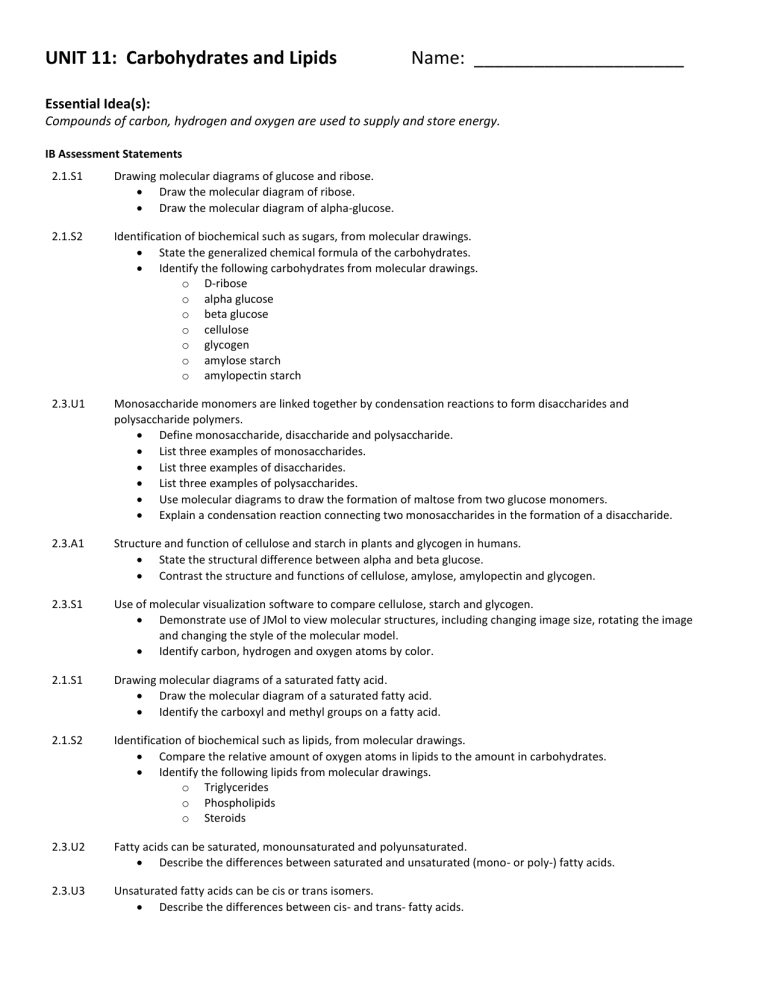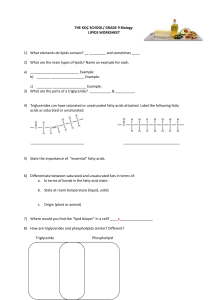
UNIT 11: Carbohydrates and Lipids Name: _____________________ Essential Idea(s): Compounds of carbon, hydrogen and oxygen are used to supply and store energy. IB Assessment Statements 2.1.S1 Drawing molecular diagrams of glucose and ribose. Draw the molecular diagram of ribose. Draw the molecular diagram of alpha-glucose. 2.1.S2 Identification of biochemical such as sugars, from molecular drawings. State the generalized chemical formula of the carbohydrates. Identify the following carbohydrates from molecular drawings. o D-ribose o alpha glucose o beta glucose o cellulose o glycogen o amylose starch o amylopectin starch 2.3.U1 Monosaccharide monomers are linked together by condensation reactions to form disaccharides and polysaccharide polymers. Define monosaccharide, disaccharide and polysaccharide. List three examples of monosaccharides. List three examples of disaccharides. List three examples of polysaccharides. Use molecular diagrams to draw the formation of maltose from two glucose monomers. Explain a condensation reaction connecting two monosaccharides in the formation of a disaccharide. 2.3.A1 Structure and function of cellulose and starch in plants and glycogen in humans. State the structural difference between alpha and beta glucose. Contrast the structure and functions of cellulose, amylose, amylopectin and glycogen. 2.3.S1 Use of molecular visualization software to compare cellulose, starch and glycogen. Demonstrate use of JMol to view molecular structures, including changing image size, rotating the image and changing the style of the molecular model. Identify carbon, hydrogen and oxygen atoms by color. 2.1.S1 Drawing molecular diagrams of a saturated fatty acid. Draw the molecular diagram of a saturated fatty acid. Identify the carboxyl and methyl groups on a fatty acid. 2.1.S2 Identification of biochemical such as lipids, from molecular drawings. Compare the relative amount of oxygen atoms in lipids to the amount in carbohydrates. Identify the following lipids from molecular drawings. o Triglycerides o Phospholipids o Steroids 2.3.U2 Fatty acids can be saturated, monounsaturated and polyunsaturated. Describe the differences between saturated and unsaturated (mono- or poly-) fatty acids. 2.3.U3 Unsaturated fatty acids can be cis or trans isomers. Describe the differences between cis- and trans- fatty acids. 2.3.U4 Triglycerides are formed by condensation from three fatty acids and one glycerol. Outline the difference between fats and oils. Explain a condensation reaction connecting fatty acids and glycerol to form a triglyceride. State two functions of triglycerides. D.1.S2 Use of databases of nutritional content of foods and software to calculate intakes of essential nutrients from a daily diet. Use a computer application to keep a record of food consumed in a single day. Compare tracked food intake to the recommended intake of nutrients. 2.3.A2 Scientific evidence for health risks of trans fat and saturated fatty acids. Discuss the relationship between saturated fatty acid (cis and trans) intake and rates of coronary heart disease. 2.3.NOS Evaluating claims- health claims made about lipids in diets need to be assessed. Describe how the effect of lipids on health can be assessed scientifically. 2.3.A4 Evaluation of evidence and the methods used to obtain the evidence for health claims made about lipids. Define evaluation in respect to evidence from and methods of research. Outline the manner in which the implications of research can be assessed. Outline the manner in which the limitations of research can be assessed. Evaluate a given health claim made about lipids. 2.3.S2 Determination of body mass index by calculation or use of a nomogram. Calculate BMI using the formula. Determine BMI using a nomogram. Outline effects of a BMI that is too high or too low. 2.3.A3 Lipids are more suitable for long term energy storage in humans than carbohydrates. Explain the energy storage of lipids compared to that of carbohydrates. D.1.S1 Determination of the energy content of food by combustion. Explain how a calorimeter can be used to determine the energy content in food. Calculate the energy content of a food sample using calorimetric data. REVIEW Four classes of biological macromolecules: 1. ___________________________ Polymers are made up of smaller parts called _________________ 2. ___________________________ Polymers are formed through ______________________________ 3. ___________________________ Polymers are broken apart through a ________________________ 4. ___________________________ Carbohydrates STRUCTURE: Made of ____, ____ and ____ FUNCTIONS: 1. Immediate… “Carbo” – 2. Energy storage for… “Hydrate” – 3. Raw material for … Often end in… About 17 KJ of energy per dry gram. About the same as protein, but ½ that of lipids 4. Important role in… MONOSACCARIDES: Backbone of… Form… Characterized by… Have several… so they are… (The many –OH groups can hydrogen bond with water molecules) DISACCHARIDES: Two… Formed through… Drawing POLYSACCHARIDES: Polymers of… Costs little… Easily reversible = Carbohydrate Type Alpha-Glucose C6H12O6 Mono Beta-Glucose C6H12O6 Mono D-Ribose C5H10O5 Mono Deoxyribose C5H10O4 Mono Maltose C__H__O__ Di Sucrose C12H22O11 Di Structure Function Carbohydrate Type Lactose C12H22O11 Function Di Storage Starch – amylose Polymer of alpha-glucose Structure Poly unbranched Starch amylopectin Storage Polymer of alpha-glucose branched about every 30 glucose Poly Glycogen Polymer of alpha-glucose branched every 8-12 glucose Storage Poly Structure Cellulose Polymer of Beta-glucose Poly Reactions between Carbohydrates Both bile acids and vitamin D are manufactured from steroid fats Functions of Lipids Oily secretions of the sebaceous glands help to waterproof the fur and skin. The preen gland of birds produces a secretion which performs a similar function on the feathers. Bess use wax in constructing their larval chambers What are lipids? Phospholipids are found in all cell membranes. Myelin is secreted by Schwann cells and insulates some neurons in such a way that nerve impulse transmission is made much more rapidly. All lipids contain large… Most lipids are therefore… Diverse in… Do not form… High energy yield per mass and insolubility in water make fats and oils ideal energy storage compounds particularly where dispersal or locomotion requires mass be kept to a minimum, as in some seeds and fruit The waxy cuticle of insects and plants reduces water loss by evaporation since water cannot cross the insoluble lipid layer. FUNCTIONS OF LIPIDS An important group of hormones, including cortisone, testosterone and estrogen are steroids. Plant scents are derivatives of fatty acids. They are attractive to insects and thus aid pollination. The shock absorbing ability of subcutaneous fat stores protects delicate organs such as the kidneys from damage Fats conduct heat very poorly; subcutaneous fat stores help heat retention in endothermic animals. Incompressible blubber is an important insulator in diving mammals Type of Lipid General Structure Triglycerides Formed by condensation reactions: 3 fatty acids + glycerol triglyceride FAT = OIL = Function: Compared to carbohydrates: Waxes Form… Composed of long …. Highly… Solid… Steroids Have a backbone of… i.e. cholesterol Different steroids created by attaching different… other examples include: 1. 2. 3. 4. 5. Different structures create… • Have mostly... A fatty acid is a long chain of mostly carbon and hydrogen atoms with a –COOH group (“carboxyl”) at one end. The hydrocarbon chain can vary in length, from about 4 to about 24 carbons long, depending on the types of fatty acids Saturated • Are typically... • Are often from... Fatty Acids • Have one (mono-) or more (poly-)... Unsaturated • Are typically... • Are often from... Cis-unsaturated Trans-unsaturated Phospholipids Formed by attachment of two fatty acids plus a phosphate group to a glycerol in condensation reactions Are the main structural component of… Why is this important? HYDROPHOBIC AND HYDROPHILLIC Fatty acid tails = PO4 head = Phospholipids in water can self-assemble into: Early evolutionary state of cells? Nutritional Content of Food 1. Determine your estimated calorie needs per day: _________________ http://health.gov/dietaryguidelines/2015/guidelines/appendix-2/ 2. Determine the recommended amount of food from each group PER DAY given your daily calorie needs http://health.gov/dietaryguidelines/2015/guidelines/appendix-2/ FOOD GROUP CARBOHYDRATES: Vegetables SUGGESTED DAILY AMOUNT ACTUAL AMOUNT CARBOHYDRATES: Fruits CARBOHYDRATES: Grains CARBOHYDRATES/PROTEINS/LIPIDS: Dairy PROTEINS: Protein LIPIDS: Oils Other Body Mass Index Body Mass Index (BMI) is a person's weight in kilograms divided by the square of height in meters. A high BMI can be an indicator of high body fatness. BMI can be used to screen for weight categories that may lead to health problems but it is not diagnostic of the body fatness or health of an individual. TOO HIGH TOO LOW BMI Nomogram – a graphical calculating diagram Health Risks of Trans fat and Saturated Fatty Acids http://www.webmd.com/diet/trans-fats-science-and-risks?page=1 http://www.heart.org/HEARTORG/HealthyLiving/HealthyEating/Nutrition/TransFats_UCM_301120_Article.jsp#.VrJZs9IrJpg http://www.heart.org/HEARTORG/HealthyLiving/HealthyEating/Nutrition/SaturatedFats_UCM_301110_Article.jsp#.VrJaVNIrJpg TRANS-FATS 1. What are trans-fats? 2. Where did trans-fats come from? Why are they used? 3. Which foods contain trans-fats? 4. How do trans-fats affect health? SATURATED FATS 5. What are saturated fats? 6. Which foods contain saturated fats? 7. How do saturated fats affect health? 8. Are all fats bad? Evaluating Health Claims Implications Limitations Calorimetry What do you do? Why do you do it? How do you do it? Calories = (mass of water in g) X (specific heat of water in cal/g°C) X (change in water temp in °C) 1 mL of water volume = 1 g of water mass Specific heat of water is 1 cal/ g°C






